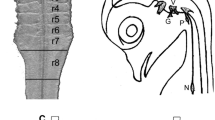Summary
This study demonstrates that retinoic acid (RA), an active metabolite of vitamin A, can act to enhance regeneration of neurites, at physiologic concentrations, in vitro. Explanted fragments of mouse dorsal root ganglia (DRG) and mouse and human spinal cord (SC) were maintained, in vitro, for periods up to 11 d. Murine DRG neurons were exposed to RA concentrations ranging from 100 µM to 1 nM, whereas neurons within murine and human SC explants were exposed to 10 µM to 10 nM RA. Results show that RA significantly (P<0.001) increases mean neurite length but not neurite number. Specifically, murine DRG neurons showed increases in mean neurite length of 30.7% with individual explants showing increases of up to 133.5%. Murine and human SC showed mean enhancements of 43.4 and 58.1%, respectively, but did so at lower concentrations of RA. The results indicate that RA may play a potentially critical role in neuronal regeneration.
Similar content being viewed by others
References
Bionique Laboratories. Bloomingdale Road, Saranac Lake, N.Y.
Bonanni, S.; Levinson, S.; Wolf, G., et al. Glycoproteins from the hamster respiratory tract and their response to vitamin A. Biophys. Acta 297:441–451; 1973.
Brand, N.; Petkovich, M.; Krust, A., et al. Identification of a second retinoic acid receptor. Nature 332:850–853; 1988.
Chytil, F. Retinoic acid: biochemistry, pharmacology, toxicology and therapeutic use. Pharmacol. Rev. 36:935–942; 1984.
De Boni, U.; Crapper McLachlan, D. R. Controlled induction of Alzheimer type paired helical filaments in cultured human neurons, by glutamate and aspartate. J. Neurol. Sci. 68:105–118; 1985.
De Boni, U.; Anderchek, K. E. Quantitative analysis of filopodial activity of mammalian neuronal growth cones, in exogenous, electrical fields. In: Nucitelli, R., ed. Ionic currents in development. New York: Alan R. Liss, Inc.; 1986:285–293.
De Boni, U.; Mintz, A. H. Curvilinear motion of fluorescent chromatin domains and nucleoli in neuronal interphase nuclei. Science 234:863–866; 1986.
Diem, K.; Lentner, C. Geigy scientific tables. In: Diem, K.; Lentner, C., eds. Units of measurement, body fluids, composition of the body, nutrition, vol. 1, 7th ed. Basel, Switzerland: Ciba Geigy; 1981.
Felber, S. M.; Brand, M. D. Concanavalin A causes an increase in sodium permeability and intracellular sodium content of pig lymphocytes. Biochem. J. 210:893–897; 1983.
Ferrari, N.; Vidali, G. Effects of retinol on chromatin structure. Eur. J. Biochem. 151:305–310; 1985.
Fung, L. C.; De Boni, U. Modulation of nuclear rotation in neuronal interphase nuclei by nerve growth factor, by GABA and by changes in intracellular calcium. J. Cell Mot. Cytoskel. 10:363–373; 1988.
Green, S.; Chambon, P. Carcinogenesis: a superfamily of potentially oncogenic hormone receptors. Nature 324:615–617; 1986.
Hardy, M. H. The use of retinoids as probes for analyzing morphogenesis of glands from epithelial tissues. In Vitro Cell. Dev. Biol. 25:454–459; 1989.
Haskell, B. E.; Stach, R. W.; Werrbach-Perez, K., et al. Effect of retinoic acid on nerve growth factor receptors. Cell Tissue Res. 247:67–73; 1987.
Kanje, M.; Lundborg, G.; Edstrom, A. A new method for studies of the effects of locally applied drugs on peripheral nerve regeneration in vivo. Brain Res. 439:116–121; 1988.
Liu, H. M.; Takagaki, K.; Schmid, K. In vitro nerve-growth-promoting activity of human plasma alphal-acid glycoprotein. J. Neurosci. Res. 20:64–72; 1988.
Lotan, R.; Kramer, R. H.; Neumann, O., et al. Retinoic acid-induced modifications in the growth and cell surface components of a human carcinoma (HeLa) cell line. Exp. Cell Res. 130:401–414; 1980.
Napoli, J. Quantification of physiological levels of retinoic acid. In: Chytil, F.; McCormick, D., eds. Methods in enzymology (123). Vitamins and coenzymes (H). New York, NY: Academic Press; 1986.
Niles, R. M.; Loewy, B. P. Induction of protein kinase C in mouse melanoma cells by retinoic acid. Cancer Res. 49:4483–4487; 1989.
Nolen, G. A. The effects of prenatal retinoic acid on the viability and behavior of the offspring. Neurobehav. Toxicol. Teratol. 8:643–654; 1986.
Parfianowicz, J.; Hawrylko, S.; Pietrzak, J., et al. Morphology and cytochemistry of the nerve cells of the spinal ganglia. Folia Morph. Warsaw 30:423–431; 1971.
Petkovich, M.; Brand, N.; Krust, A., et al. A human retinoic acid receptor which belongs to the family of nuclear receptors. Nature 330:444–450; 1987.
Phillips, T. S.; Tsin, A. T. C.; Reiter, R. J., et al. Retinoids in the bovine pineal gland. Brain Res. Bull. 22:259–261; 1989.
Rosoff, P. M.; Cantley, L. C. Increasing the intracellular Na+ concentration induces differentiation in a pre-B lymphocyte cell line. Proc. Natl. Acad. Sci. USA 80:7547–7550; 1983.
Shubeita, H. E.; Sambrook, J. F.; McCormick, A. M. Molecular cloning and analysis of functional cDNA and genomic clones encoding bovine cellular retinoic acid-binding protein. Proc. Natl. Acad. Sci. USA 84:5645–5649; 1987.
Sidell, N. Retinoic acid-induced growth inhibition and morphologic differentiation of human neuroblastoma cells in vitro. JNCI 68:589–596; 1982.
Sidell, N.; Schlichter, L. Retinoic acid blocks potassium channels in human lymphocytes. Biochem Biophys. Res. Commun. 138:560–567; 1986.
Slack, J. M. W. We have a morphogen. Nature 327:553–554; 1987.
Smith, J. E.; Milch, P. O.; Muto, Y. The plasma transport and metabolism of retinoic acid in the rat. Biochem. J. 132:821–827; 1973.
Strickland, S.; Mahdavi, V. The induction of differentiation in teratocarcinoma stem cells by retinoic acid. Cell 15:393–403; 1978.
Thaller, C.; Eichele, G. Identification and spatial distribution of retinoids in the developing chick limb bud. Nature 327:625–628; 1987.
Author information
Authors and Affiliations
Rights and permissions
About this article
Cite this article
Quinn, S.D.P., De Boni, U. Enhanced neuronal regeneration by retinoic acid of murine dorsal root ganglia and of fetal murine and human spinal cord in vitro. In Vitro Cell Dev Biol - Animal 27, 55–62 (1991). https://doi.org/10.1007/BF02630895
Received:
Accepted:
Issue Date:
DOI: https://doi.org/10.1007/BF02630895




